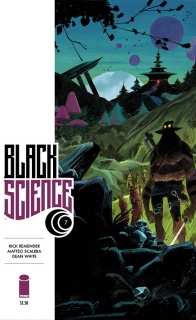As a note, spoilers for the previous arc of “Black Science” are discussed.
Abstract: When Rick Remender and Matteo Scalera left us back at the end of April, they had just killed off Grant McKay, the lead protagonist of “Black Science.” With his dying breath he tasked his arch rival Kadir with the task of returning his children home to his estranged wife. Now, we explore the question: what is the worth of a promise? Let’s dig in, faux-primary scientific literature style.

Written by Remender, R.
Illustrated by Scalera, M. and White, D.THE SECOND ARC OF THE SMASH SCI-FI HIT BEGINS HERE!
The mystery of the onion’s truth unfolds the deeper one travels. The mythology of the Eververse unveils new truths and new dangers. The team is hurled to a seemingly alien world that holds the key to their true purpose. For what is magic but science that we don’t yet understand?
Hypothesis
If the last few years have taught us anything it’s this: Rick Remender loves to screw with his readers. When he’s not stirring up readers with controversy either real or imagined (a subject this study will not attempt to breach), the writer is telling stories that grossly manipulate the expectations and emotions of readers. In killing Grant McKay, the conflicted and morally grey lead that readers had slowly come to root for, Remender changed the game in a way that few writers this side of Brian K. Vaughan are willing to do. It’s that irreverence for convention that makes this series so appealing.
That, and Matteo Scalera’s art, of course.
Materials and Methods
How do Remender, Scalera, and White manage to make such drastic changes that don’t feel like stunts or gimmicks? They do so by genuinely making you care about the characters they’ve created. Just an issue ago, Kadir was an arrogant and despicable villain responsible for not only the group’s current predicament but disaster on a multiversal scale. However, with just one issue, Kadir becomes a sympathetic underdog.
Remender has made heavy use of internal, first person narration, a technique that has its fair share of detractors. Such a technique often results in too much “telling” rather than “showing,” a major faux paux in this graphic driven medium. Of course, no once could fault “Black Science” for slacking in the realm of visual story-telling. In fact, one might argue that Remender’s character driven monologues are a strong companion to Scalera’s vividly realized sequentials.
To call Scalera the unsung hero of “Black Science” is probably a little over-the-top, as the artist has rightly received a fair amount of praise for his work on the series. However, it cannot be overstated just how crucial his influence on the series is. The artist sets the stage with double page spreads that truly count, packed with detail and content. His sense of composition is terrific, crafting panels that flow organically, telling stories without the need of text. See Fig. 2 for a terrific example.

The Shaman, perching atop a tree branch, leaps and attacks a passing lizard warrior. The flow of the panels creates a tangible sense of momentum. The first panel portrays the lizards’ rapid pursuit through the lines in the background, while also establishing the Shaman’s position. The second panel works as a sort of snapshot, a frozen moment as the Shaman takes flight. The final panel springs the scene back to life, as the trajectory established in the previous panel reaches its logical conclusion, just as a melody resolves itself.
Colorist Dean White, a fan favorite since his breathtaking work on “Uncanny X-Force,” enriches Scalera’s pencils with technicolor livelihood. The artist deserves equal credit with Scalera for this book’s terrific visuals. Finally (last but not least, and all that), there’s Rus Wooton’s distinctly crafted letters. Wooton’s thin, sharply penned letters feel wholly unique compared to the more rounded letters seen in most mainstream comics. It’s just one more thread in the rich tapestry of “Black Science.”
Unfortunately, with the spotlight on Kadir’s inner conflict, the rest of the cast doesn’t come into play as much. Taking place an indeterminate amount of time after issue #6, we have no indication as to how Pia and Nate are fairing after the death of their father. Likewise, we don’t even know how the group has gotten into its current predicament. Missing in action is Chandra, Kadir’s assistant who was left in a very interesting position at the end of the last arc. These dangling threads are made all the more apparent after the book’s extended hiatus. However, the issue’s blistering pace reaches a halt by issues end, suggesting subsequent issues will slow things down, allowing the creative team and the reader alike to catch their break and shake things out.
Continued belowResults
“Black Science” #7 is a major game changer for the book, and an incredibly strong start to its second arc. Picking up with a fun Star Wars-esque immediacy, filled with action and danger, the book hits the ground running and never lets up. All the while we’re treated to another of sci-fi worlds born in Matteo Scalera’s brilliant mind. Admittedly the book’s fast paced nature and focus on action packed hijinks doesn’t leave much time to catch up with the cast after the last arc and the long break. However, Kadir receives a heavy dose of development and is quickly rising to fill Grant’s shoes. Ultimately, the issue is just a blast to read.When the story ends, screeching to anabrupt and disheartening stop, you’ll be left begging for the next chapter. Science wins (Fig. 3).

Conclusions: 8.8 – “Black Science” hits the ground running with its second arc, is as fine a book as ever.



